Adaptive pores in next generation membranes
Due to the COVID-19 crisis measures the PhD defence of Hanieh Bazyar will take place (partly) online in the presence of an invited audience.
The PhD defence can be followed by a live stream.
Hanieh Bazyar is a PhD student in the research group Soft matter, Fluidics and Interfaces (SFI). Her supervisor is prof.dr.ir. R.G.H. Lammertink from the Faculty of Science and Technology.
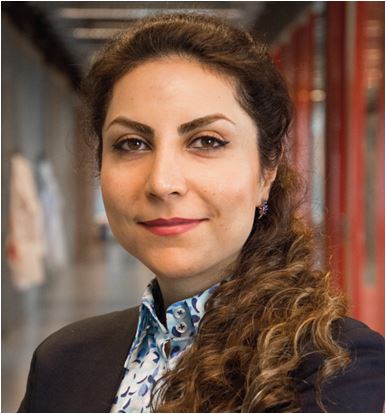 This thesis combines fundamental and applied studies on slippery liquid-infused membranes (SLIMs). SLIM is a newly introduced concept to membrane science and technology which is inspired by slippery liquid-infused porous surfaces (SLIPS). These surfaces are a novel class of functional surfaces which are introduced to address shortcomings of the well-known materials with non-wetting properties, i. e. superhydrophobic surfaces. Examples of these shortcomings include failure at elevated pressure and temperature as well as inability to repel low surface tension liquids. The fabrication procedure of liquid-infused surfaces includes infusion of the porous structure/membrane with an infusion liquid which has low surface tension. The chemical compatibility between the base material and the infusion liquid is a requisite to ensure a high affinity between these two. Once this criteria is satisfied, the infusion liquid spontaneously infiltrates the surface structure/pores via capillary wicking and forms a smooth lubrication layer on the surface. Presence of this lubrication layer is responsible for important features of these materials such as, low water contact angle hysteresis, self-healing and repelling a variety of liquids. A general introduction about nature-inspired functional materials such as, superhydrophobic, liquid-infused surfaces and their properties are discussed in Chapter One. The idea of smart gating membranes stemming from opening/closing capability of the pores, is further explored in detail.
This thesis combines fundamental and applied studies on slippery liquid-infused membranes (SLIMs). SLIM is a newly introduced concept to membrane science and technology which is inspired by slippery liquid-infused porous surfaces (SLIPS). These surfaces are a novel class of functional surfaces which are introduced to address shortcomings of the well-known materials with non-wetting properties, i. e. superhydrophobic surfaces. Examples of these shortcomings include failure at elevated pressure and temperature as well as inability to repel low surface tension liquids. The fabrication procedure of liquid-infused surfaces includes infusion of the porous structure/membrane with an infusion liquid which has low surface tension. The chemical compatibility between the base material and the infusion liquid is a requisite to ensure a high affinity between these two. Once this criteria is satisfied, the infusion liquid spontaneously infiltrates the surface structure/pores via capillary wicking and forms a smooth lubrication layer on the surface. Presence of this lubrication layer is responsible for important features of these materials such as, low water contact angle hysteresis, self-healing and repelling a variety of liquids. A general introduction about nature-inspired functional materials such as, superhydrophobic, liquid-infused surfaces and their properties are discussed in Chapter One. The idea of smart gating membranes stemming from opening/closing capability of the pores, is further explored in detail.
In Chapter Two the fabrication and characterization of these membranes are explained in detail. All fabricated membranes show a high advancing water contact angle (≃ 120°) together with low contact angle hysteresis (< 5°) ensuring high droplet mobility (slipperiness). The key working mechanism of SLIM, namely the gating mechanism is further deeply explored. The liquid-infused pore acts like a gate which can open and close in response to the immiscible feed fluid pressure. In the open state, the pore wall is still covered with the infusion liquid forming liquid-lined pores which are responsible for anti-fouling properties of these membranes. The liquid film thickness lining the pores is experimentally estimated using gas-liquid displacement experiments and theoretically predicted using annular two phase flow models. Figure 1 depicts liquid-infused pores with and without liquid-lining in the open state. The repeated ability of the infusion liquid to close the pores (gating) is further studied.
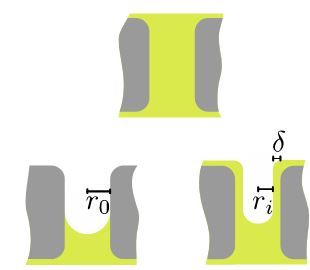
Figure 1. Liquid-infused pores with liquid-lining (right hand side) and without liquid-lining (left hand side) in the open state. r0 is the initial pore radius, ri is the effective pore radius including liquid-lining and δ is the liquid film thickness (Chapter Two).
To further investigate the applicability of SLIMs for separation purposes, the retention of the infusion liquid inside the pores are studied in Chapter Three. Liquid-liquid displacement (LLD) experiments are performed using pure water at relatively high flux values and the corresponding pressures are measured. The results reveal the underlying immiscible displacement mechanism, namely capillary fingering which leads to preferential flow pathways for water transport through the membrane. Macroscopic observations using a microfluidic model porous media (micromodel) further confirm the fractal patterns correspond to capillary fingering with trapped infusion liquid. The presence of liquid-lined pores are observed in both LLD and macroscopic observations showing the potential of these membranes for separation processes. The schematic illustration of the displacement mechanism is shown in Figure 2.
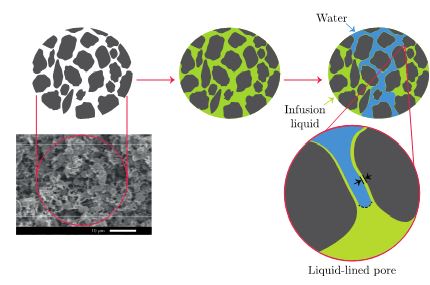
Figure 2. Immiscible displacement in SLIM using pure water showing preferential flow path ways for water transport as well as liquid-lined pores after water permeation (Chapter Three).
The pressure responsive pores which can be opened and closed in response to the system pressure can be used for efficient sorting of fluids from a mixture. In that sense, the capability of liquid-infused membranes (LIMs) are investigated for selective permeation of the dispersed phase (oil) from an oil-in-water (O/W) emulsion (as representative of oily wastewater) in Chapter Four. Unlike normal membrane filtration in which the continuous phase (water) is permeated through the membrane, the challenge here is to permeate the dispersed phase (oil). In order to permeate the oil phase, oil droplets should transport throughout the bulk of the emulsion to reach the membrane surface. This is achieved here by gravity-driven creaming in dead-end filtration mode. The results reveal that by setting the feed pressure between the entry pressure of oil and that of the aqueous surfactant solution, oil can be selectively permeated. At high surfactant concentration, water also permeates partly. The amount of permeated water through liquid-infused membranes is lower than that through non-infused counterparts (dry membrane). The improved performance of LIMs is due to the presence of liquid-lining which leads to the formation of three-phase interfaces in the pore, namely the interface between surfactant solution-oil (g12) and that between oil-infusion liquid (g23) (see Figure 3). This additional interface between oil and infusion liquid gives rise to an increase in the total interfacial tension values (g12 + g23) and thus liquid entry pressure for the surfactant solution leading to less water permeation.
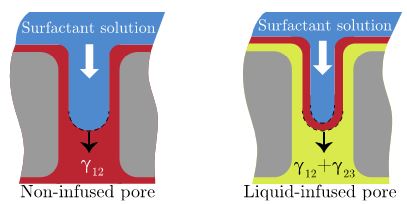
Figure 3. Comparison of liquid-infused and non-infused pore for oil permeation from an O/W emulsion containing surfactant solution. g12 is the interfacial tension between surfactant solution and oil (red) and g23 is that between oil and infusion liquid (yellow) (Chapter Four).
The presence of liquid-lining in liquid-infused membranes during permeation prevents the direct contact between permeating fluid and solid membrane material. This can subsequently lead to anti-fouling properties which are specifically important to curtail membrane biofouling. If the initial phase of microorganism attachment to the pore wall is inhibited, a remarkable reduction in biofilm formation can be obtained. The anti-biofouling performance of LIMs is studied in Chapter Five by conducting cross flow filtration experiments for approximately 20 days. The results reveal a lower increase in transmembrane pressure (TMP) values for LIMs compared to dry membranes. As a relevant and accessible parameter, the TMP values as a function of time are fitted to growth curve models (logistic model) to obtain the bacterial growth parameters. This type of modeling quantifies the biofouling behaviour of membranes in terms of the lag period l, the bacterial growth rate (mm) and the asymptotic value A. The modeling results show an increase in l from approximately 3 days in dry membranes to 10 days in LIMs. A substantial decrease in the growth rate from 0.35 1/day for dry membranes to 0.05 1/day for LIMs are also observed. These results together with flow cytometry results confirm the ability of LIMs to mitigate biofouling due to the presence of liquid-lining. This is schematically shown in Figure 4.
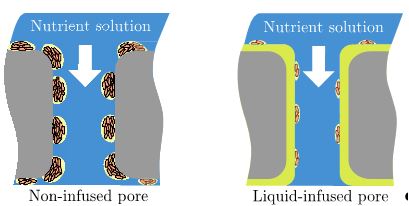
Figure 4. Comparison of anti-biofouling performance of liquid-infused and non- infused pores. Presence of liquid-lining prevents direct contact with the microorganisms and thus mitigate biofilm formation and growth (Chapter Five).
Membranes have a wide range of application in wastewater treatment, including oily wastewater or produced water. This kind of wastewater is the largest waste stream in the oil and gas industry which mainly contains dispersed oil, dissolved organics/inorganics and suspended solids. All the membrane processes suffer from fouling which further limits their widespread applications. To address this issue, in Chapter Four, we presented the idea of oil permeation (instead of water) through the membrane. Oil permeation can suppress surface and internal fouling mainly due to the coalescence of oil droplets on the membrane surface and the absence of oil droplets as the foulant material. Coalescence of oil droplets on the membrane surface requires movement of oil droplets towards the membrane surface. A simple approach, used in Chapter Four, is the use of intrinsic density difference between oil and water phases leading to gravity-driven creaming. However, this technique is a rather slow process which highly depends on the droplet size (creaming velocity scales with the square of the droplet radius). Additionally, it is not suitable for density matched liquids. Alternatives include the use of an external field such as an acoustic or electric field. In Chapter Six a fundamental study is performed on the movement of oil droplets in an O/W emulsion using an acoustic field (acoustophoresis). To avoid the statistical uncertainties arising from polydispersity of oil droplets in an emulsion, monodisperse oil droplets were employed. The monodisperse emulsions were made using hydrocarbon oil (hexadecane) and silicone oil in aqueous surfactant solutions of different concentrations. The acoustophoretic behaviour of monodisperse oil droplets was investigated in a microfluidic chip with one inlet and three outlets (see Figure 5). The acoustic energy density is a key design parameter for acoustic manipulation of particles/droplets. However, due to the energy losses of the acoustic waves, it remains a challenge to theoretically predict or experimentally determine the acoustic energy density. Here, the acoustophoretic velocity of monodisperse oil droplets was measured using particle image velocimetry (PIV) and the corresponding acoustic energy was calculated. The results show no effect of surfactant concentration on acoustophoretic velocity as well as energy density. A general relationship was obtained for the calculation of the acoustic energy density.
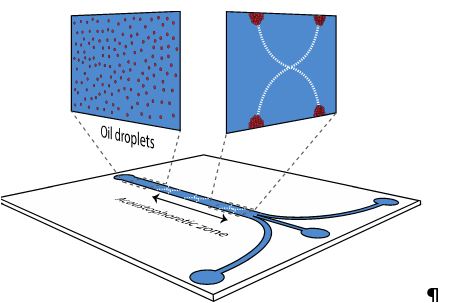
Figure 5. Movement of oil droplets towards pressure anti-nodes in a microfluidic acoustophoresis chip upon application of acoustic field (Chapter Six).
Permeability is an important transport property of any porous media which plays an important role in further application processes. Experimental measurements of permeability is time-consuming and expensive since new sets of experiments must be performed on a case-by-case basis. Thus, accurate prediction of permeability is of significant importance. Numerical prediction of permeability suggest a universal scaling power-law for normalized permeability. In Chapter Seven we aim to experimentally validate this power-law relation using micromodels with different porosity values. To be more realistic, micromodels consist of random arrays of cylindrical pillars which are designed using Monte Carlo simulations are used (see Figure 6). The micromodels are fabricated in silicon wafer using deep reactive ion etching process. The experiments are performed by pushing pure water or oil (hexadecane), with higher viscosity, through the micromodels at different pressure values and measuring the corresponding flow. The analogous scaling power-law relation is obtained for the normalized permeability which shows good agreement with the numerical prediction.
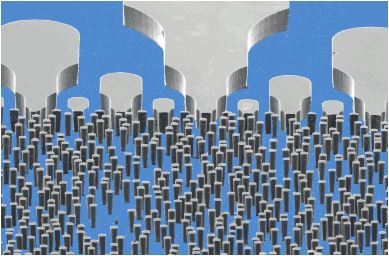
Figure 6. Pure water (blue) has been pushed through a micromodel consisting random arrays of cylindrical pillars as a representative of porous media (Chapter Seven).
The overall overview to the work together with reflections and perspectives are presented in Chapter Eight. The idea of gravity-driven oil permeation through the membranes is further discussed in crossflow filtration mode and at low oil concentrations. The applicability of electric field as the external field for the movement of oil droplets, together with the corresponding challenges and the future outlook are touched upon.





